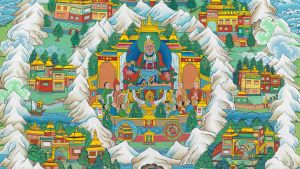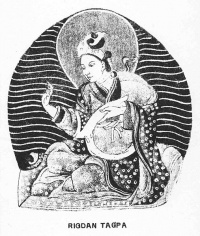Difference between revisions of "Manjushrikirti"
| (One intermediate revision by the same user not shown) | |||
| Line 1: | Line 1: | ||
[[File:Evf hambhala.jpg|thumb]] | [[File:Evf hambhala.jpg|thumb]] | ||
| − | [[File:Rigdan Tagpa.jpg|thumb|200px|[[Rigden Trakpa]] or [[Manjushríkírti]], King of [[Shambhala]])] | + | [[File:Rigdan Tagpa.jpg|thumb|200px|[[Rigden Trakpa]] or [[Manjushríkírti]], [[King]] of [[Shambhala]])]] |
| − | '''[[Manjushrikirti]]''' or ''[[Manjughoshikirti]]'' (Skt. [[Mañjuśrīkīrti]]; {{Wiki|Chinese}}: [[妙吉祥稱]]; pinyin: [[Miàojíxiángchēng]]; Wylie: [[Jam-dpal Grags-pa]], ZYPY: [[Qambai Chagba]]). [[Manjushrikirti]] is said to have been the eighth [[Kings of Shambhala|king of Shambhala]] and is considered to be the second [[incarnation]] in the [[lineage]] of the [[Panchen Lamas]] of [[Tibet]]. As his [[name]] indicates, is considered to have been an [[incarnation]] of [[Manjushri]], the [[Bodhisattva]] of [[Wisdom]]. | + | |
| + | |||
| + | |||
| + | |||
| + | |||
| + | |||
| + | |||
| + | '''[[Manjushrikirti]]''' or ''[[Manjughoshikirti]]'' (Skt. [[Mañjuśrīkīrti]]; {{Wiki|Chinese}}: [[妙吉祥稱]]; pinyin: [[Miàojíxiángchēng]]; [[Wylie]]: [[Jam-dpal Grags-pa]], ZYPY: [[Qambai Chagba]]). [[Manjushrikirti]] is said to have been the eighth [[Kings of Shambhala|king of Shambhala]] and is considered to be the second [[incarnation]] in the [[lineage]] of the [[Panchen Lamas]] of [[Tibet]]. As his [[name]] indicates, is considered to have been an [[incarnation]] of [[Manjushri]], the [[Bodhisattva]] of [[Wisdom]]. | ||
| + | |||
| + | |||
| + | [[Manjushrikirti]] was born in [[Shambhala]], the son of [[King]] [[Deva]]-[[Indra]] and his [[Wikipedia:Queen consort|queen]], Kauśikí. His {{Wiki|rule}} is said to have extended over "hundreds of petty [[kings]] and a hundred thousand cities." He is said to have expelled 300,510 followers of {{Wiki|heretical}} [[doctrine]] of the Mlechhas or "{{Wiki|materialistic}} {{Wiki|barbarians}}", some of whom worshipped the {{Wiki|sun}}, but after reconsidering, he brought them back and they asked for his teachings. Next he united all the [[castes]], or [[religious]] factions, of [[Shambala]] into one [[Vajra]] or '[[Diamond]]' [[Caste]]. Consequentially, he was the first [[king of Shambhala]] to be given the title [[Kalki]] (Tib. [[Rigden]]), meaning "[[Holder of the Castes]]" or "[[Wisdom]] Holder." | ||
| − | |||
He is said [[Tibetan]] sources to have taken the [[throne]] 674 years after the [[death]] of [[Gautama Buddha]]. Following the [[Tibetan]] sources, which place the [[parinirvana]] in 833 BCE, he would have become [[king of Shambhala]] in 159 BCE. There is, however, no consensus on the date of the [[death]] of the [[Buddha]]. {{Wiki|Modern}} [[scholars]] have proposed dates of 563, 483, 410 or 400 BCE. These would suggest dates for his accession of 111, 191, 264 or 274 CE respectively. | He is said [[Tibetan]] sources to have taken the [[throne]] 674 years after the [[death]] of [[Gautama Buddha]]. Following the [[Tibetan]] sources, which place the [[parinirvana]] in 833 BCE, he would have become [[king of Shambhala]] in 159 BCE. There is, however, no consensus on the date of the [[death]] of the [[Buddha]]. {{Wiki|Modern}} [[scholars]] have proposed dates of 563, 483, 410 or 400 BCE. These would suggest dates for his accession of 111, 191, 264 or 274 CE respectively. | ||
| + | |||
He then put the [[Kalachakra]] teachings in a condensed and simplified [[form]] called the "[[Sri Kalachakra]]" or "[[Laghutantra]]". | He then put the [[Kalachakra]] teachings in a condensed and simplified [[form]] called the "[[Sri Kalachakra]]" or "[[Laghutantra]]". | ||
| − | This work is also called the Condensed [[Kālachakra]] [[Tantra]] (bsdus rgyud, [[laghutantra]]). It is usual now simply called the [[Kālachakra]] [[Tantra]], the original longer version one is no longer extant. | + | This work is also called the Condensed [[Kālachakra]] [[Tantra]] ([[bsdus rgyud]], [[laghutantra]]). It is usual now simply called the [[Kālachakra]] [[Tantra]], the original longer version one is no longer extant. |
| + | |||
| + | |||
==[[Lineage]] of the [[Panchen Lamas]]== | ==[[Lineage]] of the [[Panchen Lamas]]== | ||
| + | |||
| + | |||
In the [[lineage]] of the [[Panchen Lamas]] of [[Tibet]] there were considered to be four "[[Indian]]" and three [[Tibetan]] [[incarnations]] of [[Amitabha Buddha]] before [[Khedrup Gelek Pelzang]], who is recognised as the [[1st Panchen Lama]]. The [[lineage]] starts with [[Subhuti]], and [[Manjushrikirti]] is considered the second [[incarnation]]. | In the [[lineage]] of the [[Panchen Lamas]] of [[Tibet]] there were considered to be four "[[Indian]]" and three [[Tibetan]] [[incarnations]] of [[Amitabha Buddha]] before [[Khedrup Gelek Pelzang]], who is recognised as the [[1st Panchen Lama]]. The [[lineage]] starts with [[Subhuti]], and [[Manjushrikirti]] is considered the second [[incarnation]]. | ||
| + | |||
{{R}} | {{R}} | ||
[[Wikipedia:Manjushrikirti]] | [[Wikipedia:Manjushrikirti]] | ||
| − | |||
[[Category:Shambhala]] | [[Category:Shambhala]] | ||
Latest revision as of 09:31, 20 July 2024
Manjushrikirti or Manjughoshikirti (Skt. Mañjuśrīkīrti; Chinese: 妙吉祥稱; pinyin: Miàojíxiángchēng; Wylie: Jam-dpal Grags-pa, ZYPY: Qambai Chagba). Manjushrikirti is said to have been the eighth king of Shambhala and is considered to be the second incarnation in the lineage of the Panchen Lamas of Tibet. As his name indicates, is considered to have been an incarnation of Manjushri, the Bodhisattva of Wisdom.
Manjushrikirti was born in Shambhala, the son of King Deva-Indra and his queen, Kauśikí. His rule is said to have extended over "hundreds of petty kings and a hundred thousand cities." He is said to have expelled 300,510 followers of heretical doctrine of the Mlechhas or "materialistic barbarians", some of whom worshipped the sun, but after reconsidering, he brought them back and they asked for his teachings. Next he united all the castes, or religious factions, of Shambala into one Vajra or 'Diamond' Caste. Consequentially, he was the first king of Shambhala to be given the title Kalki (Tib. Rigden), meaning "Holder of the Castes" or "Wisdom Holder."
He is said Tibetan sources to have taken the throne 674 years after the death of Gautama Buddha. Following the Tibetan sources, which place the parinirvana in 833 BCE, he would have become king of Shambhala in 159 BCE. There is, however, no consensus on the date of the death of the Buddha. Modern scholars have proposed dates of 563, 483, 410 or 400 BCE. These would suggest dates for his accession of 111, 191, 264 or 274 CE respectively.
He then put the Kalachakra teachings in a condensed and simplified form called the "Sri Kalachakra" or "Laghutantra".
This work is also called the Condensed Kālachakra Tantra (bsdus rgyud, laghutantra). It is usual now simply called the Kālachakra Tantra, the original longer version one is no longer extant.
Lineage of the Panchen Lamas
In the lineage of the Panchen Lamas of Tibet there were considered to be four "Indian" and three Tibetan incarnations of Amitabha Buddha before Khedrup Gelek Pelzang, who is recognised as the 1st Panchen Lama. The lineage starts with Subhuti, and Manjushrikirti is considered the second incarnation.

